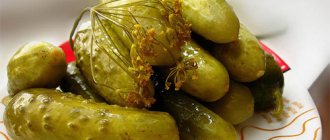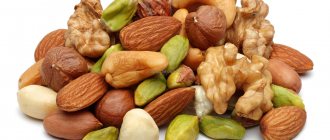A nursing mother needs fruits, berries, and fresh vegetables rich in vitamins and microelements in her diet to maintain her body and nourish her baby. Many red and sweet berries are contraindicated due to allergenic properties and are introduced into the menu carefully, and some are completely excluded. Is it possible to use pomegranate while breastfeeding? Let’s look at it below.
Pomegranate is undoubtedly useful during breastfeeding and will only benefit the mother if she does not have an individual intolerance to it.
Benefits of pomegranate during breastfeeding
The fruit grows in tropical and subtropical regions. Its most valuable components:
- Sahara;
- tannin;
- vitamin C;
- cellulose;
- trace elements and minerals: calcium, magnesium, potassium, manganese, sodium.
More than 20% of the product consists of natural glucose and fructose, which are necessary as a source of energy to feed the brain. These sugars are well absorbed by the body.
Tannin is a tannin found in the peel and membranes of the fruit. It also has astringent properties. It affects the functioning of the digestive system, strengthens the stool and is often used in folk medicine as a remedy against diarrhea, for healing wounds and burns on the skin. Thanks to its tanning properties, the growth of pathogenic flora on the surface and inside the body is suppressed.
Ascorbic acid strengthens the walls of blood vessels, reduces their permeability, it is a powerful antioxidant, a regulator of redox processes. It protects cells from adverse effects and is used for skin diseases, inflammation of the gastric mucosa, increasing immunity, and restoring bone and connective tissue. Vitamin C promotes the absorption of iron in the gastric mucosa, therefore it is prescribed for iron deficiency anemia. Used in cosmetology to lighten age spots. Creams and exfoliants are made with it.
The mineral complex, consisting of Na and K, is the main component in the ion pump of cell membranes. Thanks to this, cells live. Magnesium is involved in the functioning of the heart and blood vessels, lowers blood pressure, normalizes heart rate, improves sleep and increases stress resistance. Calcium is necessary in the construction of bone and connective tissue, manganese - for brain function, gonadal function, and hematopoiesis.
Dietary fiber is important for intestinal motility, movement of food through the gastrointestinal tract, and regular evacuation of contents from the rectum.
In addition to the above, pomegranate contains malic, citric, oxalic acids, and plant phytoncides.
Reviews of nursing mothers eating pomegranate
Women who are breastfeeding, in most cases, respond positively to the use of pomegranate in their diet:
- I started using pomegranate seeds when the baby was 4 months old. I think I felt better myself. I am inclined to think that this is the rich vitamin and mineral composition of the grains.
- I gradually began to drink pomegranate juice only when my son was 6 months old. I introduced it with an amount of 1 teaspoon.
- I don’t like this fruit myself, but the pediatrician advised including it in the diet, since the baby needed to balance the hemoglobin in the blood.
Red fragrant and juicy pomegranate can have a beneficial effect on the mother’s body. It should not be used thoughtlessly. In this case, the correct dosage and the right moment of introduction into the diet are important. And then the effect will be only positive, and possible negative manifestations will be minimized.
How pomegranate can harm you while breastfeeding
Pomegranate is useful during lactation. Because of its valuable components, it is recommended in the diet of a nursing woman. But everything needs moderation. Astringent and fastening components, if consumed excessively, will cause constipation not only in the mother, but also in the baby.
Although the fruit is not an obligate allergen, allergic reactions in the form of skin rash, swelling, and itching are possible even with a single use of pomegranate fruit or juice. No one knows how a baby will react to the introduction of a new product.
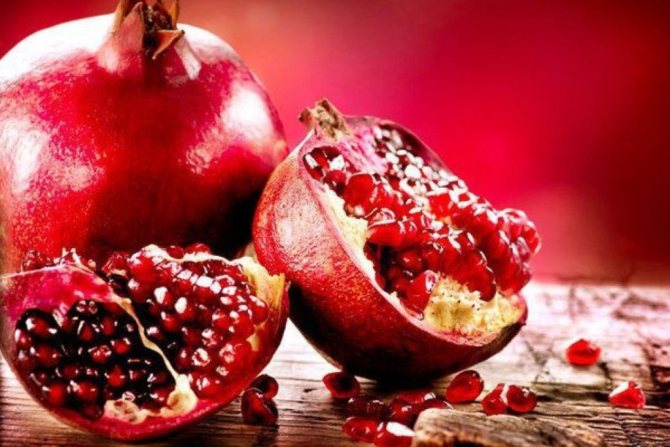
Rarely, but individual intolerance to pomegranate is possible. This will also affect the child’s digestion: bloating, colic, pain, frequent regurgitation, loose stools mixed with greens are possible.
Therefore, even such a healthy product as pomegranate must be used in the diet with extreme caution so as not to harm the child and not provoke an exacerbation of the mother’s diseases.
How to properly introduce pomegranate into your diet during breastfeeding
Experts answer in the affirmative the question of women can consume pomegranate while breastfeeding . But it is very important to introduce it correctly into your diet. Only in this case can we ensure that there is no negative reaction from the baby.
They begin no earlier than when the child is 3 months old. First, take 2-3 grains and see if allergic reactions occur. Only then, after 2-3 days, you can eat a few more grains.
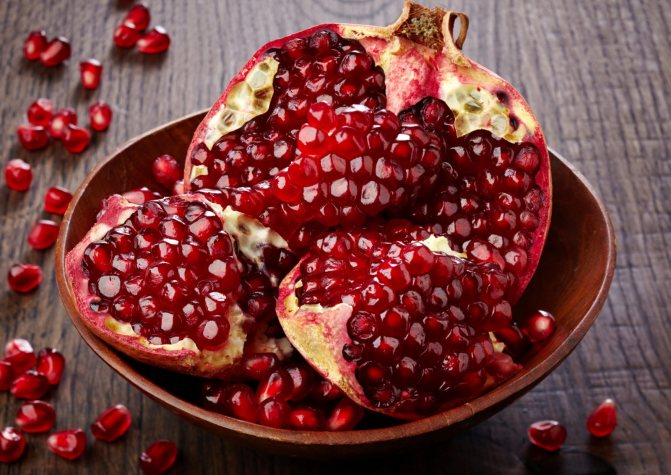
In what form can a nursing mother eat pomegranate?
It is advisable to consume several grains at first. Moreover, you should not eat bones in the early stages. Just suck out the juice. In this form, you can start taking this fruit in the early stages.
Then the volume is increased, but also left in the form of juice from the grains. Only after a month of eating grains can you switch to squeezed juice, and after some more time, start chewing the seeds.
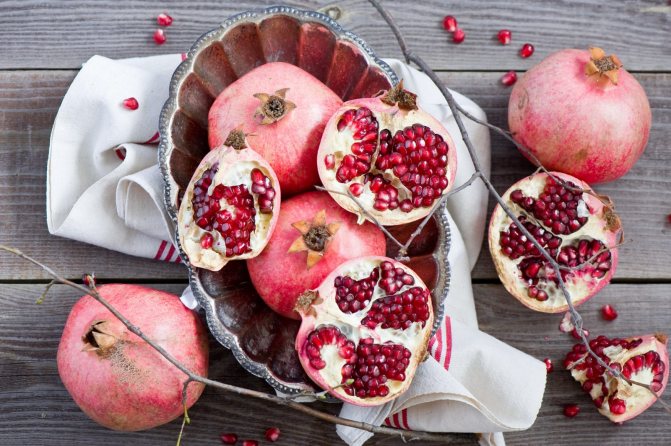
Rules for choosing a pomegranate for a nursing mother
Of course, these should not only be the ripest fruits, but, most importantly, grown without the use of pesticides and other chemicals. This is the only way to get the benefits of the fruit.
If you buy a fruit in a store, you need to pay attention to the integrity of its peel, uniform coloring and absence of dents. Another tip is that the outer skin should be brown in color and appear a little dry, and not vice versa, as juicy as possible. Only in this case the grains will be as red as possible.
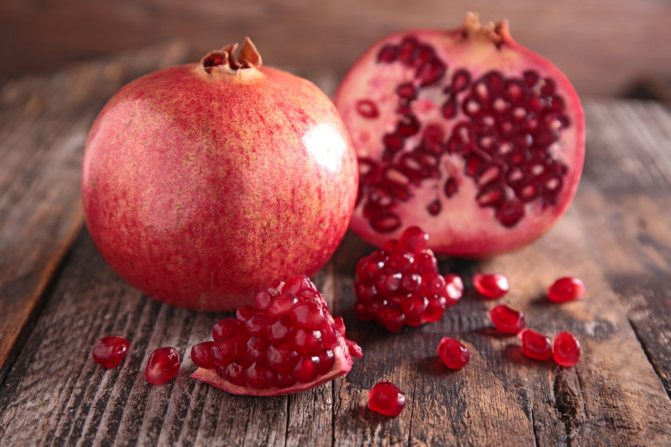
How to store pomegranate
Pomegranate is stored in the refrigerator if it is maximally ripe.
If there is doubt about the degree of its ripeness, then you can put the fruit in a plastic bag with apples and wrap it tightly. The gases released from the apples will contribute to the ripening of the pomegranate.
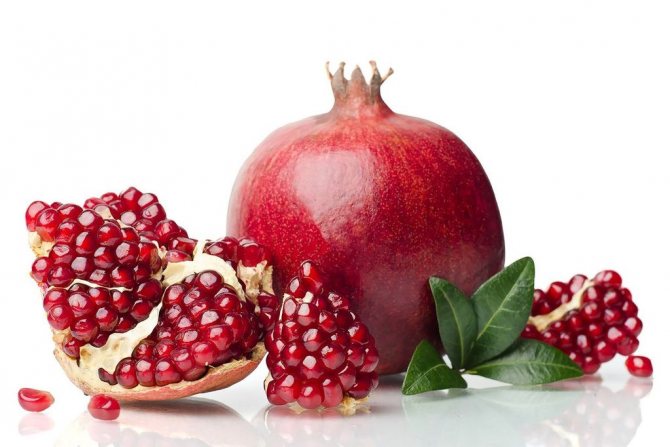
How and when to introduce pomegranate into a mother’s daily diet
Like all new products, it is not recommended to introduce pomegranate juice and pulp into the diet in the first month. It is better to do this when milk production is normalized and the mother’s lactation has become stable. The child will get used to new living conditions and nutrition. The best time for this is 3-4 months of the child’s life. Another important condition is the complete health of the baby.
You cannot introduce 2 or more products into your diet at the same time. If a child reacts with a pathological reaction, then it is impossible to understand what specific product this happened to.
You should start eating pomegranate with a few grains or a quarter glass of juice.
It is better in the morning to observe the baby’s behavior and manifestations of the skin and digestion throughout the day. The product should be eaten immediately after feeding, so that by the next breastfeeding its concentration in milk becomes minimal.

It is worth introducing pomegranate into the diet from several seeds, carefully monitoring the baby’s reaction to the new product.
How to drink pomegranate juice
Pomegranate juice, like fresh fruit, contains a lot of useful substances, while there is no coarse fiber in its composition. Another advantage of juice over fresh pomegranate is the ability to minimize contact with tooth enamel if you drink through a straw.
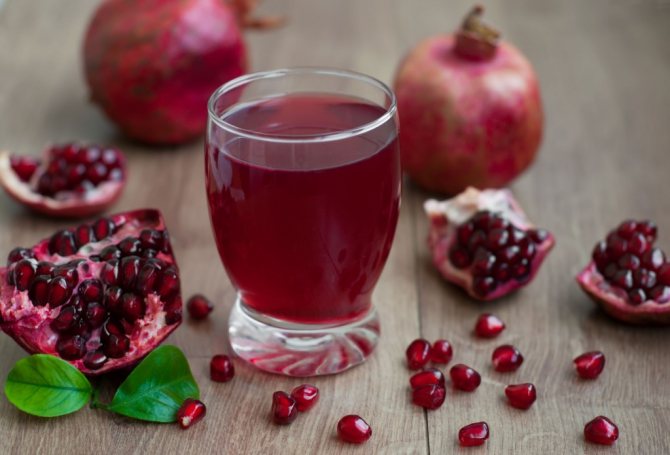
Nursing mothers are recommended to drink freshly squeezed juice from high-quality ripe pomegranate fruits
To safely include juice in your diet, consider the following recommendations:
- Try to drink freshly squeezed juice. Store-bought drinks may be of poor quality or contain sugar and dangerous additives: preservatives, dyes and others. Most store-bought juices are reconstituted, made from dry concentrate. This drink no longer has high nutritional value. Therefore, choose whole, directly pressed juices from store-bought ones.
- Dilute the juice with boiled water in a ratio of 1 to 1. This will make its composition less “aggressive” for the stomach. Gradually reduce the proportion of water, moving to pure juice.
- The first portion of juice should not exceed 30 ml, and you should drink it no more than once a week. Time after time, increase the volume of natural juice, bringing it to the daily norm of 50 ml.
- Do not use metal containers for preparing or storing juice. This will avoid oxidation of the drink from contact with metal.
You can make juice using a citrus juicer or by hand. Mash the fruit with your hands, then make a hole with a knife and pour the released liquid into a glass.
In what form is it better to eat pomegranate?
The fruits are eaten fresh, the juice is squeezed, added to salads, meat and fish dishes when preparing food, and sauces and drinks are prepared.
When consuming fruit grains, you should eat the pulp alone without the kernels. They can provoke dyspeptic disorders of the stomach and intestines: pain, heaviness, nausea, changes in stool.
How to choose a pomegranate
You can buy grenades in a store or market. Rotten, too soft fruits are definitely not considered for selection. A pomegranate must have certain external qualities and taste:
- Color ranges from pale yellow to deep burgundy, depending on the variety. Dark, black spots indicate poor storage and rot damage. This fruit is set aside.
- The peel is thin, leathery, dry, hard and has a slight shine. If the rind is too soft and juicy, it indicates that the fruit has fallen from the tree prematurely, is unripe, or has been poorly transported.
- The fruit should be heavy, that is, contain a lot of grains and juice. The weight of a large fruit is up to 700 grams. When pressed, the grains crackle. Too light a fruit indicates a dry product.
- A ripe fruit and well-stored flower has a flower. It is dry, colored in the color of the fruit, opened. A damaged inflorescence with a dark spot in the middle indicates immaturity and violation of storage conditions.
- When cutting the fruit, the grains should be surrounded by transparent pulp and separated by veins. The pulp is juicy. It determines the amount of pomegranate juice and taste. It is better not to eat fruit with wrinkled and dry grains.
The optimal time to buy fruit is October or November. This is the period of pomegranate ripening. It must be stored at low temperatures and relatively high humidity to prevent drying out. The shelf life under these conditions is up to 8 months. Sour varieties are preserved better than sweet varieties. You can freeze individual pomegranate seeds by placing them in a bag.
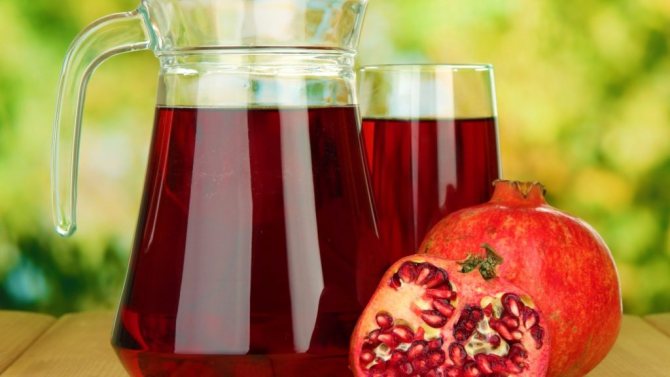
High-quality pomegranate juice is recommended for consumption during breastfeeding.
How to choose pomegranate and pomegranate juice?
It is advisable not to purchase juice in the store, but to squeeze it yourself. You need to know how to choose the right grenades to avoid negative consequences.
Rules for choosing a pomegranate:
- The fruit must be dry on the outside. If the peel is wet, you should discard this product;
- Overly dried fruit is also not good. This may mean prolonged and improper storage;
- The fruit must be clean, without dents, stains or rot. Spots are a sign of overripeness or improper transportation;
- The color of the garnet should be dark red with small orange flecks. The fruit itself should have slightly woody skin;
- The tail of the fruit should be the same color. A green tail indicates its immaturity;
- When weighing pomegranates of the same size, preference should be given to the heavier fruit. This means it is riper;
How to choose juice:
Pomegranate juice should only be purchased from trusted manufacturers.
- It is advisable to purchase in glass containers. The full name of the manufacturer must be read on the label;
- The label “nectar” indicates that it is diluted. The color of the juice should be deep red. Brown color indicates that rose hips have been added to it or the product is made from fruit crusts;
- The price should not be low, because pomegranate juice is an expensive pleasure. Cheap juice should be avoided;
- The production date must correspond to the pomegranate ripening season. High-quality juice is produced in the fall (September – December);
- When choosing, be sure to pay attention to the expiration date. A good product will have a short shelf life. The long shelf life means it contains a lot of preservatives. Such juice will not bring any benefit and may even cause harm;
- Also, you should not purchase products that are almost expired or already expired. Such a product may harbor harmful bacteria.
Drinking pomegranate juice during breastfeeding
Pomegranate juice during breastfeeding is without a doubt a healthy product and is necessary in the diet of a nursing woman. Preference is given to making juice at home. It does not contain preservatives, dyes, stabilizers, or sugar. Chemical additives in the factory-made drink will have a negative effect on the body of the mother and child.
You need to start using it with a quarter glass, after diluting it with water, gradually increasing the amount to half a glass of pure product.
The juice must be diluted with water before consumption, because the acid contained in it causes an exacerbation of diseases of the digestive tract, especially in people with diseases accompanied by high acidity of the stomach.
To summarize whether a nursing mother can eat pomegranate, we note that this fruit is rich in vitamins and minerals that are necessary for the mother and the growing body. But excessive uncontrolled consumption can cause exacerbation of digestive diseases, constipation in the mother and will have a pathological effect on the baby, for example, stool constipation, allergies.
Recommendations for use
- Introduce pomegranate and pomegranate juice into your diet during lactation no earlier than three months after birth. The optimal age of the baby is 5-6 months;
- For the first test, eat one or two pomegranate seeds in the morning and observe the baby’s reaction for two days. If there are no negative consequences, you can safely eat pomegranate while breastfeeding;
- If you have stomach problems or allergies, it is too early to introduce fruit into your diet. You can try again at least a month after the first test;
- Gradually increase the dosage of consumed fruit by two times in relation to the previous portion;
- Start drinking pomegranate juice with 30 ml no more than once a week. Then gradually increase the portion to 150 ml per day;
- At first, dilute the juice by half with warm water, which will reduce the aggressive composition. Then gradually reduce the dose of water and switch to a full-fledged drink;
- Do not buy ready-made juice in bags or bottles, as they often contain many preservatives, dyes and chemicals. Drink only natural freshly squeezed juice.
Remember the main principle when breastfeeding is not to overeat. After all, even safe products, if abused, can cause a negative reaction in a baby. However, if you follow nutritional recommendations for a nursing mother, you can consume many foods without risk to lactation and the baby. For more information on what foods you can eat while breastfeeding, read the link https://vskormi.ru/mama/razreshennie-produkti-pri-grudnom-vskarmlivanii/.
Subscribe to our VKontakte group
